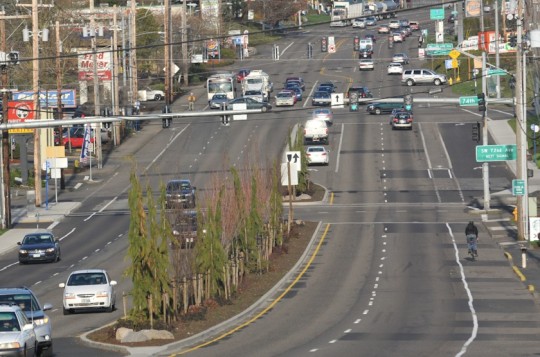
(Photo by J Maus/ BikePortland)
This post is part of our SW Portland Week.
It would certainly be ironic if Southwest Barbur Boulevard became the first arterial in Portland to receive a Copenhagen-style protected bike lane retrofit through a high-destination commercial area.
But that’s exactly what might happen if a regional committee chooses Barbur as the best route for a major new transit line. And getting around outer Southwest Portland would certainly be transformed.
“Barbur and I-5 are the options, and we’re not putting bikes on I-5. Barbur is the only option. And I think that makes it different from almost any other street in the city.”
— Anthony Buczek, Metro
“It is the flat route through the West Hills,” Metro engineer Anthony Buczek said Thursday. “Barbur and I-5 are the options, and we’re not putting bikes on I-5. Barbur is the only option. And I think that makes it different from almost any other street in the city.”
If the light rail or dedicated busway lands on Barbur, Buczek said TriMet is currently assuming that 16 feet of roadway, eight on each side of the street, would be dedicated to biking facilities. And because adding a 28-foot transitway to Barbur is already expected to require rebuilding the curbs and acquiring new land from adjacent property-owners, the region would get to build Barbur’s bike lanes and sidwalks pretty much any way it wants.
In short, there’s a chance here to completely rebuild one of Portland’s most car-oriented arterials into a world-class facility, with the federal government paying for half of it.
There are, however, four things that could send the plan off that course.
1) The transit line could go along the freeway instead
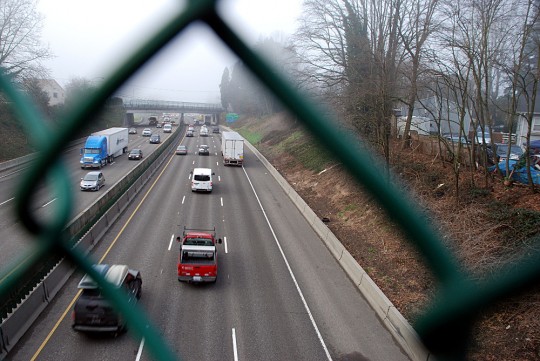
(Photo by M Andersen/BikePortland)
It’s far from a sure thing that Barbur will be chosen for the transit line’s route through Southwest Portland. A steering committee of elected officials from around the region might instead recommend a path on the hillside immediately northwest of Interstate 5. Commissioner Steve Novick said Friday that the Oregon Department of Transportation has been urging consideration of the freeway option.
“Which I think many people in the city aren’t excited about,” Novick continued.
In an interview Thursday, Southwest Neighborhoods Inc. transportation committee chair Roger Averbeck agreed that a Southwest Corridor plan that didn’t include changes to Barbur would be unpopular with many people he represents, in part because Barbur must be built more densely, and presumably made more pleasant to spend time on, if the transit line will have enough ridership to justify its cost.
“If we can’t tame the beast that is Barbur, that’s going to be more controversial,” Averbeck said.
Advertisement
Buczek and Metro planner Michaela Skiles said it’s not yet clear whether the freeway route would cost more or less than the Barbur route. Buczek said a freeway route would be reminiscent of TriMet’s Green Line along I-205:
While a route along Barbur would be more like the Yellow Line along Interstate Avenue, except with a second general travel lane in each direction rather than parking lanes.
Officially, the plan is to improve Barbur for biking and walking within 1/2 mile of transit stations even if the transit line runs along I-5. But if Barbur’s curbs aren’t being moved to make room for transit lanes, the biggest changes to the corridor might get scrapped.
2) High-quality bike lanes might be seen as taking up too much space
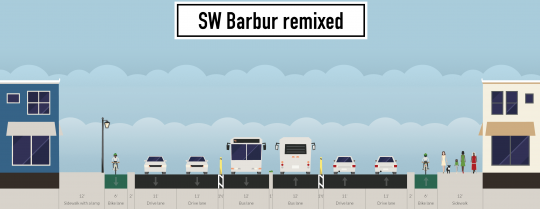
Continuous strips of land along a busy street are expensive. When every foot is precious, it’s easy to imagine 16 feet of bikeway coming to be seen as excessive once costs come into focus.
Meanwhile, car lanes may take up 48 feet of roadway width. Buczek said the assumption is that Barbur’s would be either 11 or 12 feet wide after the rebuild.
“We’re hoping for 11,” Buczek said. But the road currently belongs to the Oregon Department of Transportation, so it’s largely up to that agency.
Because wider lanes are known to encourage speeding, the Association of American State Transportation Officials says that on urban streets with many traffic signals and 35 mph speed limits or less, lanes should be as narrow as 10 feet.
3) Money might run short
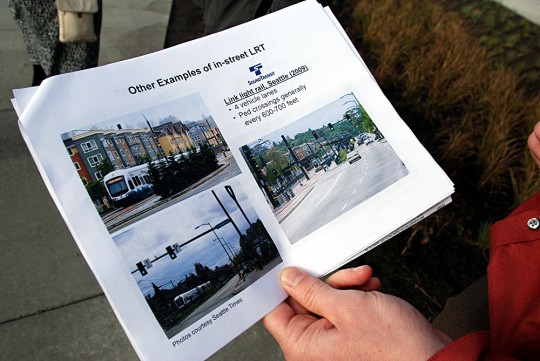
Another possibility, as we reported Monday, is that the line might include a rail tunnel beneath Marquam Hill. Though the line would probably meet up with Barbur’s commercial strip eventually, tunnel construction could add a billion dollars to the price of the project, sucking up all available funding and forcing more corners to be cut elsewhere.
“The tunnel thing is hard,” Novick said. “We don’t know where we’re going to get the money for local match for any options.”
4) Suburban voters might kill the transit project
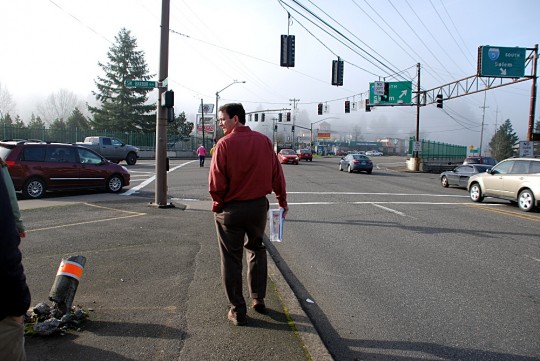
(Photo by M Andersen/BikePortland)
Last spring, Tigard voters gave themselves the right to vote directly on any high-capacity transit in their city. If they vote to block transit, it’d likely kill the Southwest Corridor project.
Last fall, Tualatin voters gave themselves the right to vote directly on any light rail transit in their city. Though that wouldn’t prevent dedicated bus lines, bus service might be seen as infeasible because even the big vehicles associated with bus rapid transit don’t carry as many people as light rail transit.
“During the peak hour, LRT could run at 7.5-minute frequencies, while BRT would need to run at 3-minute frequency to serve demand,” Metro spokesman Craig Beebe said. Because that’d require more than twice as many drivers — until self-driving buses might come into use, at least — that’d approximately double the cost of operating the new line.
On the other hand, halving the time between transit arrivals would certainly make the line convenient to use.
Even in a best-case scenario where Tigard and Tualatin sign off on the Southwest Corridor, the project isn’t expected to be built for 10 to 20 years: between 2025 and 2035.
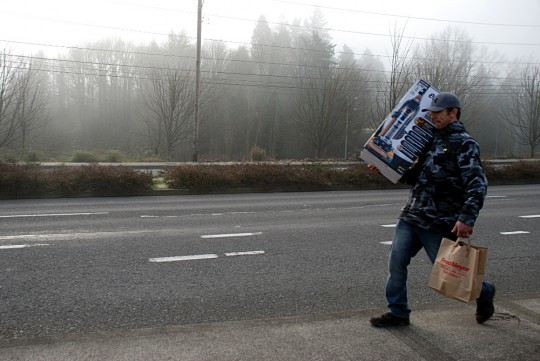
(Photo by M Andersen/BikePortland)
It’s a long time to wait, especially for a day that might never come.
On the other hand, Buczek said, the fact that the Portland region is planning to deal with increased traffic by adding transit lines and bikeways, rather than widening the road to six auto lanes, is itself unusual.
“Fortunately, no one’s talking about that, because we live in a sane place,” Buczek said. “If we were in Phoenix, we’d be talking about that.”
“If we were in Florida, we’d have already built it,” Beebe added.


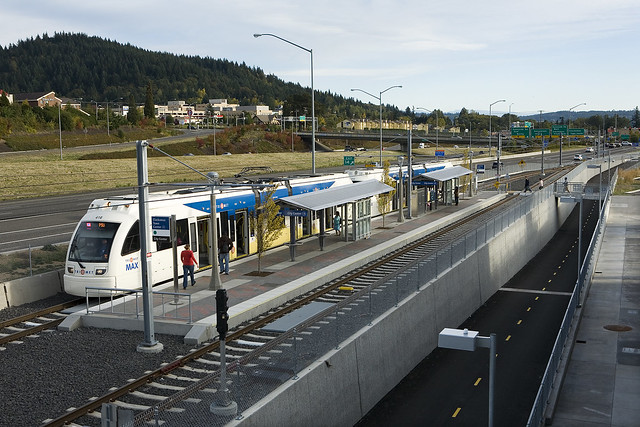
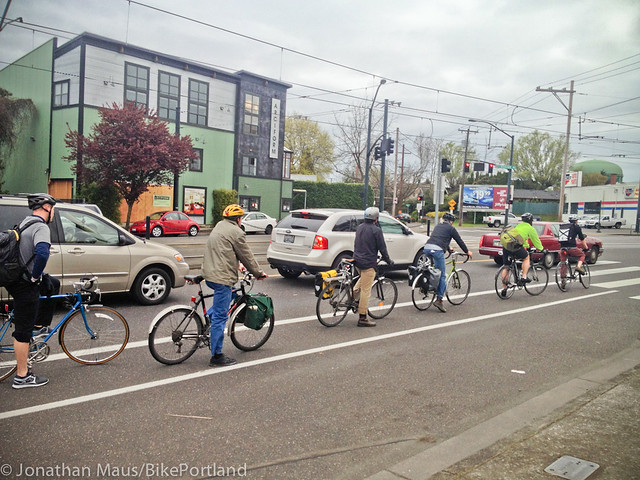
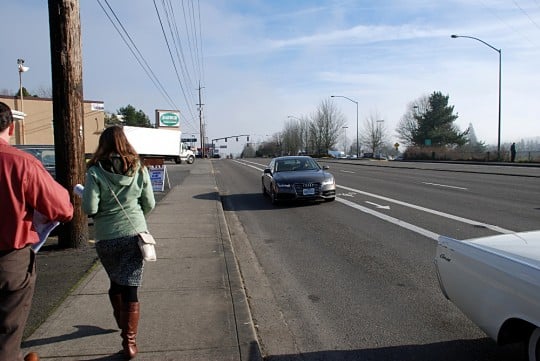

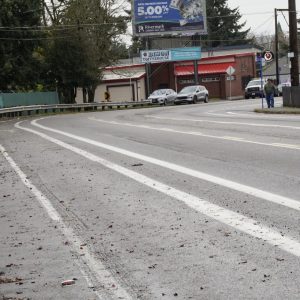
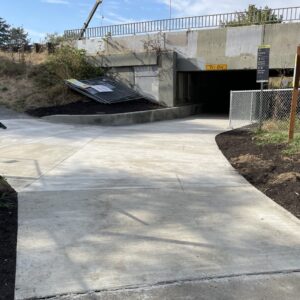
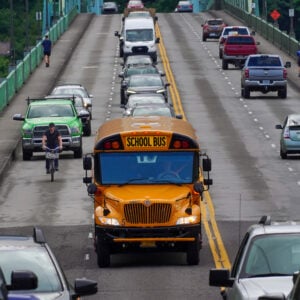
Thanks for reading.
BikePortland has served this community with independent community journalism since 2005. We rely on subscriptions from readers like you to survive. Your financial support is vital in keeping this valuable resource alive and well.
Please subscribe today to strengthen and expand our work.
I’m kind of surprised a freeway alignment hasn’t already been eliminated from the list. No one really wants it, it doesn’t serve the needs of anyone along the line very well. The only advantage would be if the cost estimates came in very significantly under a Barbur alignment, which is unlikely.
I was surprised too. Max along 205 is kind of OK, but I5 with the twists and hills is a different beast.
Transit along interstate highways is best left to high speed commuter rail and not MAX style light rail…the land use and multimodal catchment sheds for station areas are not as good vs. urban arterial routes…then there is the air quality…and noise…for bikes and peds.
A 6 lane road in Phoenix is considered a collector road. 🙂
10-20 years sounds like a ridiculously long timeline. Why would it take so long?
Politics, funding, legal issues. Property has to be acquired, environmental analyses, voter approval, blah, blah, blah. Highly unlikely substantial changes will happen in 10 years, and 20 years might turn out to be optimistic.
It takes at least 5 years to build something once it is designed. It may take 5 years+ just to decide what to do and design it.
And before that, there is consensus to reach, an environmental impact statement to write, politics to navigate…
But those Max tracks are terrible for people on bikes! (You have to interact with the tracks in some way, at some point.) That’s why I’d rather see Max go through a tunnel. We can get better bike infrastructure another way. If BRT is the way we go, then you still have to deal with buses, bus stops, and bus riders. (Did I miss something where the tunnel option has been killed?)
I’d prefer a subway over current light rail. I think more bus service along with off-set bus stops are needed on Barbur and BH Highway.
So Tigard doesn’t want transit, and SW Portland has used its outsized influence to fight density increases. Why should we build this project? High-capacity transit only makes sense if it serves dense areas.
Tigard and Tualatin voters got suckered by the anti-transit red-state republicans from Clackamas county.
A lot of Tigard residents want the congestion in Tigard to ease; it’s just that a slim majority want to be able to have a say in the transit options above the current status quo, and not let Metro and Tri-Met have free play. Which on the surface, sounds reasonable– but that measure was designed to kill the other options outside of the status quo, dooming Tigard and Tualatin (and, by extension, Sherwood, Wilsonville, and Newberg) to the current and growing traffic mess and restricted growth options.
FWIW, a lot of my Tigard neighbors and friends voted against that stupid measure– just not enough of them to defeat it.
No question that Tigard needs some congestion relief, and light rail may be essential to dealing with congestion. Tigard has some of the same problem Beaverton does, with a big ol’ highway running right down the center of town. Trimet though, does have a rep of being a big stomping gorilla. It’s not a surprise that the agency got the thumbs down from a lot of residents.
For those who have some time to do some homework, please review the 2013 Barbur Concept Plan: https://www.portlandoregon.gov/bps/55269
or https://www.portlandoregon.gov/bps/article/441477
If you don’t have much time scroll down to the the final recommendations on page 49.
Keep in mind that I-205 was built with a “transitway” in place, so putting in the Green Line was about as easy as they come. Prospects for development around stations out there? Not good or at least tough to do.
LRT/BRT has to serve OHSU, either via tunnel (elevator as per Wash. Park) or if Naito or Barbur get the nod, via a first class covered escalator of some sort. The latter options serve South Portland, and the Naito option would at last be a change to transform that old expressway.
The short tunnel makes sense moneywise, but that leaves Hillsdale off the line, and its crying for dense development on all those parking lots. Forget Multnomah. Barbur from Burlingame to West Portland just begs for a serious makeover, and some nodes already exist…Burlingame, 19th (Safeway), 30th, West Portland (Barbur TC).
I think we should argue for this line even if it just goes to PCC Slyvania; forget the suburbs if they want to be left behind for now. I would find a way to Kruse Woods, the Bridgeport and forget the two Ts.
Local funding? A regional vote on a property tax bond would be best.
SW needs a bike / ped bridge from SW 52nd Ave to the Markham School (on SW Capitol Highway). This bridge would go over both Barbur and I-5 with a connection from Barbur.
Picture at the top of this story, looking east: shows the intersection accessing Fred Meyer in Tigard. In the picture, count the number of motor vehicles in use: about 40, including buses and trucks. Count the number of bikes in use: Two, maybe three.
The section of Hwy 99W shown, which several miles further east becomes Barbur Blvd, is relatively flat until the intersection, then begins to rather dramatically climb for about a mile and half, nearly to the intersection with Capitol Hwy. PCC Sylvania is south of 99W, with some additional climbing.
If it’s important to try arrive at some estimation of how much increase in use bike lanes on this section of 99W-Barbur may come to have in years to come, the amount of motor vehicle use on this road, and the hill that people biking must climb, most likely is important to consider.
East of the intersection with Capitol Hwy, I’ve rarely ridden 99W-Barbur, basically because the volume of motor vehicle use on the road makes that ride awful. There’s less climbing on this section of the road, so that’s likely to be a plus in favor of people that want or need to ride it.
FYI I posted a series of helmet came videos to YouTube showing what it looks like to ride Barbur/Pacific Highway from Hall to Lane and back again. Search for “Barbur Tour commuter” in YouTube to find them. They are 4 years old but I don’t think conditions have changed that much since then.
Maybe it’s time I redid the series.